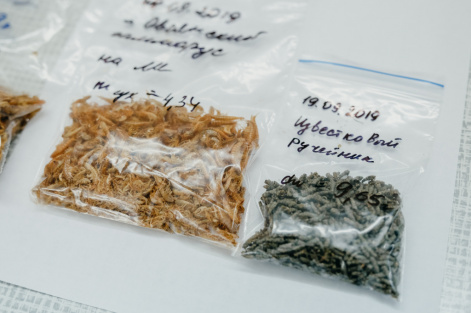Biota in the Yenisei helps scientists monitor the plutonium concentration in the river
28 September 2021 г.

The production of weapons-grade plutonium, which began in Zheleznogorsk in 1958, along with its processing, led to the entrance of transuranium elements such as plutonium, americium, and curium into the Yenisei River. Plutonium isotopes entering the Yenisei with discharges decay very slowly and therefore, they will remain in the ecosystem for tens and hundreds of thousands of years. Transuranic elements are highly toxic to biota due to the alpha radiation emitted during their decay. Due to the recently commenced production of nuclear fuel for fast reactors and to the anticipated increase in the production and processing of nuclear fuel at MCC, it became necessary to update the data on the assessment of the amount and propagation of plutonium in the river.
A team of Siberian scientists with the leading participation of researchers of the Federal Research Center "KSC SB RAS" for the first time analyzed the long-term change in the plutonium content in the aquatic biota and bottom sediments of the Yenisei. Also, for the first time, the background level of plutonium was measured in the aquatic biota and bottom sediments of the Yenisei in the area located above the radioactive discharges. The concentration of plutonium in the species of aquatic organisms varied significantly, but with time it changed synchronously in all samples. Thus, a sharp increase in the concentration of plutonium was recorded in all the samples of the Yenisei biota in 2018. Also, during the study, a change in the ratio of plutonium isotopes in biota was recorded, which indicates a qualitative change in the technological process, resulting in the plutonium propagation.
From 2008 to 2019 the researchers sampled benthic animals and aquatic plants in the Yenisei near the place where radioactive substances were discharged, in order to assess the content of biologically available technogenic radionuclides in the river. For their research, scientists selected biota species which differ in the way they accumulate radionuclides in their biomass. For example, the aquatic moss Fontinalis Fontinalis antipyretica and the higher aquatic plant Potamogeton lucens accumulate radionuclides by absorbing them from the surface of leaves and stems from the water, the amphipods Eulimnogammarus viridis and Palaseopsis cancelloides receive it with food, namely microscopic algae which they collect from the surface of stones and aquatic plants; caddis larvae Apatania crymophila receive radionuclides from food, and they also build their houses from particles of radioactive bottom sediments.
Changes in the plutonium content in different organisms reflect the trends in the annual controlled discharges of radionuclides into the Yenisei. A significant increase in the concentration and ratio of plutonium isotopes in river organisms in 2018 coincided with an increase in the controlled plutonium discharges, which, according to the publicly available reports of the Typhoon Federal Service for Hydrometeorology and Environmental Monitoring, tripled as compared to the previous year.
In terms of increasing plutonium content in biomass, water moss reacted most strongly of all the selected living objects to a sharp increase in discharges in 2018. Scientists concluded that this species is best suited for the role of a bioindicator of discharges. At the same time, as scientists note, the best indicator of the bioavailability of plutonium is amphipod crustaceans, since they receive plutonium from food and, in turn, can further transfer it in a biologically available form to the fish eating them, for example, grayling and burbot.
“We recorded a significant increase in the plutonium concentration in the bottom sediments and biota of the Yenisei in 2018, which was preceded by a period of lower concentrations. The increase in plutonium in the biota and bottom sediments followed a threefold increase in the controlled discharge of plutonium into the river in 2018. The content of plutonium in the samples taken this year, as compared to the previous period, increased approximately by 3 times for bottom sediments and caddis larvae, 5 times for amphipods, 13 times for pondweed and 26 times for water moss, ” said the author of the study, Tatiana Zotina, Candidate of Biological Sciences, Associate Professor, Senior Researcher at the Institute of Biophysics of SB RAS.
The researchers note that benthic organisms containing plutonium serve as food for river fish and can be considered a potential source of plutonium for them. For example, the radionuclide can be transmitted along the food chain to grayling, burbot and other species for which some amphipods and other representatives of zoobenthos make up a significant part of the diet.
“We are talking about very low concentrations of plutonium, however, given its long decay period, radiotoxicity for biota, ability to accumulate in the bones and liver of animals, length of the period of its biological excretion from the human body, it makes sense to monitor its content in the environment and, possibly , to begin to think about scenarios for the spread of plutonium in the ecosystem, to predict the ways of its biological transfer and develop methods of remediation of the contaminated environment, ” explained Tatiana Zotina.
This work was supported by the Russian Foundation for Basic Research, Government of the Krasnoyarsk Region and Krasnoyarsk Regional Science Foundation (projects 20-44-240004 and 18-44-240003).
Share:
